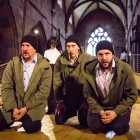Burning Fiery Furnace 2018Scottish Opera
Read more about the opera Burning Fiery Furnace
A fine performance of an unfashionable work.
There was a time when one or other of Britten's wonderful chamber operas was a fixture in the Scottish Opera repertoire, being revived and toured year after year. That was long ago, however, and those times seem unlikely to recur. Even then, the company never got round to tackling the fascinating and gripping Church Parables. Here, at last, was one of them, with a unique sound world dominated by exotic percussion effects. It was only the third production of The Burning Fiery Furnace to be seen in Scotland, following the original version from the English Opera Group that came to Edinburgh in 1968 and the Perth Festival presentation nearly thirty years later.
This also marked Scottish Opera's first visit to the Lammermuir Festival and was a performance in an ideally atmospheric venue - 'the Lamp of Lothian' - St Mary's Haddington. It was billed as a 'semi-staging', but that was a bit of a quibble as a 'full' staging of the work will always be quite economical, relying on the simplest effects of movement, lighting and costumes. The brief music drama has its own unique sound world. This should not just be a one-off event, but ought to be seen widely in other parts of the country.
The use of a church for opera performance can normally be a mixed blessing due to staging constraints. However, this particular work, a ‘church parable’ first staged in 1966, was devised and written for church performance. The economy of the event was confirmed by the re-use of a handsome platform set designed initially in 2009 by Andrew Storer for Scottish Opera's 5:15 series of short new works. It had already been utilsed for a student production of The Rape of Lucretia in 2012 and it was good to see it appear again (uncredited) in this enterpriising event.
St Mary’s Church, Haddington, seemed an admirable location; well maintained, well-lit and tastefully modernised. Technical support is naturally limited. The performing area offered a stage in front of the orchestra, thus giving some sense of a pit. Then there was an arched staircase, peaking in the centre. The stage area was set off by two resident tapestries to left and right of the stage. Otherwise there was no decoration. A frame was brought on to represent the oven. As expected, little attempt was made to adjust lighting.
Apart from scarves and crown and a golden robe for Nebuchadnezzar, the staging was spartan. The cast performed in modern dress, carrying black robes which they later donned.
The church's central aisle provided the entrance and exit for the cast. Movement and massing of groups of singers, including young boys, enhanced the drama. The band also made effective use of the available space, parading around the audience during the performance.
Britten’s haunting score took hold, and the appreciative audience of several hundred seemed fully absorbed. Diction could sometimes have been better in a resonant ecclesiastical acoustic - not all the words could be heard. However the story is straightforward and well known. Some of the central themes are timeless: in particular, the accusation against the three young men from Israel as being immigrants made a strongly topical impact.
All the soloists were effective. The small chorus included some well-known names. This production should certainly be seen more widely around Scotland, and not confined to a single performance at the Lammermuir Festival.




